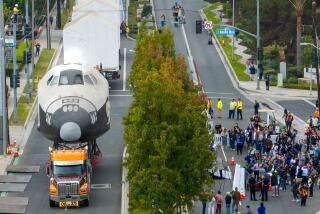The space shuttle’s Southland legacy
Bob Kahl slips in through a side door of the vast, abandoned hangar and looks at what’s left of the assembly plant where he worked for nearly 40 years.
He remembers the hum of power tools, the biting aroma of cutting oil, swarms of workers plugging away on a labyrinth of yellow scaffolding. All that’s left is a few piles of broken concrete and a sea of colorless dust that coats a Palmdale factory floor the size of two football fields.
“Welcome to the birthplace of America’s space shuttle fleet,” said Kahl, 60, smiling. “I never really thought it could come to this.”
Photos: The shuttle’s legacy in Southern California
Amid the odes to a shuttle program that ends with the last mission of the last shuttle, Atlantis, scheduled for liftoff Friday, is an awareness that the space plane helped carry Southern California’s aerospace industry for four decades. It staved off decline after the end of the moon landings, bequeathing new generations of aeronautical technology — and jobs — to the regional economy.
“Building the space shuttle fleet enabled a historic chapter in NASA’s space program,” said NASA Administrator Charles Bolden, a former shuttle commander. “Southern California has a strong place in shuttle history as a key site where the spacecraft were built and often landed.”
Constructing the shuttle fleet was testament to how advanced Southern California’s aerospace engineering and labor workforce had become by the 1970s — and assured that the vast assemblage of brainpower and engineering know-how would not be lost in the Southland.
The history of the shuttle program may be linked forever to the flights of Challenger and Columbia, its two deadly tragedies. But the shuttle era will also be remembered for advancing technology, including reusable rocket engines and computerized guidance systems, that changed manned flight.
The shuttle is considered the world’s most advanced flying machine because it blasted into space like a rocket, behaved in orbit like a floating laboratory, buzzed to and from the International Space Station with astronauts and supplies, and landed back on a runway like an airplane.
Before the shuttle, astronauts reached space by squeezing into a small capsule launched atop a massive rocket. By the time the shuttle was in design, the space program was looking for ways to keep as many as seven astronauts in orbit for weeks at a time in relative comfort.
To do this, scientists and engineers had to rethink nearly every aspect of the endeavor, notably flight controls, rocket engines and protection from searing heat generated by reentry.
“The shuttle was unlike anything that preceded it, so there were always new questions to answer,” said Dwight Woolhouse, a shuttle engineer from the beginning of the program to this day.
The shuttle — large and aerodynamically unstable — needed sophisticated computer controls to guide the flight. The system, known as “fly by wire,” is common on today’s aircraft, but it was a rarity in flying machines in the 1970s. Engineers in Downey developed the computer-aided autopilot flight controls similar to today’s systems that allow mammoth Boeing 747 jumbo jets to almost fly themselves.
Another challenge was building rocket engines sturdy enough to work flight after flight for 55 missions. Before the shuttle, rocket engines were mostly one-of-a-kind chemistry sets — good for one flight only. The main engines, made by Rocketdyne in Canoga Park, helped propel the 2,250-ton shuttle assembly as high as 384 miles above Earth.
“We were wrestling with the technology at the time,” said Robert Biggs, project engineer at Rocketdyne. “We had about 20 major accidents, but we finally got it right.”
To keep the shuttle from burning up in the furnace-like heat upon reentry, new protection was developed. More than 30,000 silica ceramic tiles were individually contoured to the spaceship’s body — like a jigsaw puzzle — dissipating heat around 2,300 degrees. The tiles, made by Lockheed Missiles & Space Co. in Sunnyvale, Calif., were key to the reusability of the shuttle.
Combined, the new technology would make space travel routine. There were 358 astronauts who reached outer space on the shuttle, whereas only 43 had gone before. The shuttle helped build the International Space Station, launched and later fixed the Hubble Space Telescope, and sent robotic probes to explore Venus, Jupiter and the sun.
During World War II, aircraft manufacturing boomed in California, with factories churning out war birds around the clock. After the war came to a close, the industry evolved from one centered around airplane manufacturing into one of cutting-edge engineering, groundbreaking science and high technology.
“Once the DNA code in aviation and aerospace was established in Southern California, it was unbreakable,” Kevin Starr, a historian, author and USC professor, said in an interview.
After the World War II work dried up, the nation was caught in the Cold War and embarked to put a man on the moon during the Mercury, Gemini and Apollo programs.
But as the moon landings came to an end, the Southland’s aerospace workforce was again at a crossroads. The four-decade-long shuttle program came at a crucial time. It provided the industry a bridge into the 21st century.
It was in Palmdale, at the edge of the Mojave Desert on the factory floor at Air Force Plant 42, that each of the shuttles — Enterprise, Columbia, Challenger, Discovery, Atlantis and Endeavour — came together for final assembly.
In addition to the major work in Downey and Canoga Park, parts of all sizes poured out of factories in California and across the nation.
The massive cargo bay, built to hold items as varied as satellites and pieces of the International Space Station, was manufactured by General Dynamics Corp. in San Diego. The landing gear struts that allowed the giant shuttle to gently touch down on a runway were built by Menasco Manufacturing Co. in Burbank. Hundreds of smaller shops made wire connectors, fuel valves and actuators — the parts that pulled everything together.
“It is the sort of program that helped build out the middle-class economic infrastructure in Southern California,” Starr said. “It provided well-paying jobs to everybody from PhDs fresh out of Caltech all the way down to the line worker with a high school degree.”
Robert G. Minor, former president of Rockwell Space Systems and now retired, recalled that the proposal to win the initial contract was 10,000 pages long and took more than a year to complete. “We knew what winning the program meant to the company and the region,” he said. “Losing was not an option.”
In 1972, North American Rockwell — later Rockwell International and now part of Boeing Co. — was named the primary contractor for the world’s first reusable winged orbiting spaceship.
At the program’s peak in 1975, about 12,000 people, stretched over 120 acres in 40 buildings, were working in Downey on the shuttles. In the San Fernando Valley, 3,500 people worked at Rocketdyne. In Palmdale, the workforce hit 1,800. Thousands of others worked at supply firms.
“The shuttle program was so pervasive that it’s hard to find an aerospace career employee in Southern California who did not have a hand in the project,” said Gerald Blackburn, president of the Aerospace Legacy Foundation, a nonprofit organization of former aerospace employees who work to preserve Southern California’s aerospace history.
There were environmental costs. Testing sites in both Canoga Park and Downey became subject to multimillion-dollar cleanups as a result of the space program.
But the shuttle’s economic footprint didn’t go away after the fleet was built. Although it was a much smaller operation than the original buildup, the Palmdale and Canoga Park sites later became high-tech Jiffy Lubes of sorts, servicing and upgrading shuttle technology.
That work continued after the space shuttle Challenger exploded after launch in 1986. After the space shuttle Columbia broke up during reentry in 2003, accident investigators concluded that the craft had “high inherent risks.” Costs that averaged more than $1 billion per launch, according to independent researchers, also helped lead to the end of the shuttle program.
The Southern California aerospace industry has been preparing for more than a decade for the day when the shuttles were grounded for good. Boeing closed the former Rockwell plant in Downey in 1999. The remaining workforce has moved to Boeing’s complex in Huntington Beach, and in June the company announced layoffs or reassignments for the last of its shuttle workers. In Canoga Park, the shuttle work at Rocketdyne — now part of Pratt & Whitney — will end this year.
But even as the space shuttle prepares to make its last venture into orbit, its technological progeny are growing and evolving into a new Space Age.
The men and women who built the shuttles, planned its science experiments, updated its hardware and guided it through space now have new assignments. Some have joined a new generation of engineers on burgeoning projects.
Boeing engineers in Huntington Beach are working to develop a seven-person spaceship that is designed to fly atop a variety of rockets and expects the spacecraft to be ready by 2015.
In Mojave, companies such as Scaled Composites and XCOR Aerospace Inc. are developing spacecraft to lift paying customers into outer space.
In Hawthorne, Space Exploration Technologies Corp., or SpaceX, plans to fill a $1.6-billion NASA contract for 12 flights to transport cargo to the International Space Station — a role that the space shuttle previously filled. The company’s 18-story rocket that will power the missions, the Falcon 9, has made two flights to orbit, with a third slated for this year.
Former shuttle astronaut Garrett Reisman is working at SpaceX to develop the company’s space capsule, dubbed Dragon, into a spaceship that can carry people, as well as cargo. The company aims to taxi astronauts to the space station for NASA by 2014.
“We’re not reinventing the wheel here. We’re just improving on technology that has come before,” Reisman said. “The shuttle era is ending, and we’re entering a period of transition. We’re getting ready to step over a new threshold in human spaceflight.”
Photos: The shuttle’s legacy in Southern California
More to Read
Inside the business of entertainment
The Wide Shot brings you news, analysis and insights on everything from streaming wars to production — and what it all means for the future.
You may occasionally receive promotional content from the Los Angeles Times.











